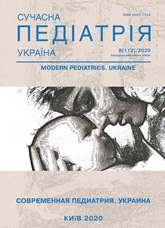Clinical and paraclinical features of course of allergic dermatosis in children
Abstract
In recent years, in most countries of the world there is a significant increase in allergic skin diseases — allergodermatoses, especially in children. Allergodermatoses include: simple and allergic contact dermatitis, atopic dermatitis, various forms of eczema, acute and chronic allergic urticaria, Quincke's edema, multiforme exudative erythema (Stevens—Johnson syndrome), acute epidermal necrolysis (Lyell's syndrome), toxicodermias, and other less common dermatoses with allergic reactions in the pathogenesis. Various disorders of the morphofunctional state of the skin and immune mechanisms of pathogenesis in children with allergic dermatoses have been insufficiently studied. That is why a promising area of research is to study clinical and paraclinical features of allergic dermatoses in children for identify possible diagnostic criteria.
Purpose — to improve the diagnostic of allergic dermatoses in children, to analyze clinical and paraclinical features of the course of allergic dermatoses, to study the indicators of cellular and humoral immunity, cytokine status, biomarkers of sensitization to allergens.
Matherials and methods. 50 children with allergic dermatoses and 32 healthy children of the control group aged 1 to 18 years were examined. General clinical, immunological, allergic and statistical research methods were used.
Results. The comprehensive study of the clinical manifestations of various allergic dermatoses in children was done. Allergic dermatoses are characterized by pronounced polymorphism of clinical manifestations, acute or chronic stage course, with the development of concomitant pathological polysystemic changes. In children with allergic dermatoses was detected disorders of the cellular immuneity with the development of an imbalance between individual subpopulations of lymphocytes: a decrease of CD3 with an increase of CD4 and a decrease of CD8, a corresponding increase of the immunoregulatory index, as well as an
increase of CD20, CD19 and CD16 in the blood. Analysis of humoral immunity in children with allergic dermatoses showed dyssimmunoglobulinemia with decrease concentration of IgA, a significant increase concentration of IgE and a moderate increase concentration of IgM, IgG in the blood. Also in children with allergic dermatoses an increase concentration of circulating immune complexes and histamine in the blood was found.
Conclusions. As the result of the conducted research similar immunological mechanisms in the pathogenesis of allergic skin diseases in children were established, together with etiologically significant factors and the only one mechanism for the formation of sensitization to allergens. The obtained data gave grounds to combine all allergic skin lesions in children into the one nosological group of allergic dermatoses. Dedicated clinical and paraclinical criteria of the diseases will promote to verify timely accurate diagnosis.
The study was conducted in accordance with the principles of the Helsinki Declaration. The research protocol was approved by the Local Ethics Committee of the institution mentioned in the work. Informed consent of parents of children was obtained for the research.
References
Akan A, Dibek-Misirlioglu E, Civelek E, Vezir E, Kocabas CN. (2020). Diagnosis of atopic dermatitis in children: comparison of the Hanifin-Rajka and the United Kingdom Working Party criteria. Allergologia et Immunopathologia. 48 (2): 175-181. URL: http://www.sciencedirect.com/science/article/pii/S0301054619301156. https://doi.org/10.1016/j.aller.2019.07.008; PMid:31611041
Beltrani VS. (1998). Allergic Dermatoses. Medical Clinics of North America. 82 (5): 1105-1133. URL: http://www.sciencedirect.com/science/article/pii/S0025712505704053. https://doi.org/10.1016/S0025-7125(05)70405-3
Bourrain JL. (2017). Toxicodermias. EMC - Dermatologia. 51 (4): 1-13. URL: http://www.sciencedirect.com/science/article/pii/S1761289617870527. https://doi.org/10.1016/S1761-2896(17)87052-7
Dowling PJ, Kader R, Portnoy JM. (2019). COLA (Conferences On-Line Allergy) at 10 Years - Evolution of an Online Fellowship Curriculum. The Journal of Allergy and Clinical Immunology: In Practice. 7 (8): 2568-2573. URL: http://www.sciencedirect.com/science/article/pii/S2213219819305975. https://doi.org/10.1016/j.jaip.2019.06.025; PMid:31279862
Fawbert K, Leech S. (2020). Recurrent urticaria and angioedema. Paediatrics and Child Health. 30 (7): 243-248. URL: http://www.sciencedirect.com/science/article/pii/S175172222030072X. https://doi.org/10.1016/j.paed.2020.04.001
Hsu DY, Brieva J, Silverberg NB, Paller AS, Silverberg JI. (2017). Pediatric Stevens-Johnson syndrome and toxic epidermal necrolysis in the United States. Journal of the American Academy of Dermatology. 76 (5): 811-817. URL: http://www.sciencedirect.com/science/article/pii/S0190962216312853. https://doi.org/10.1016/j.jaad.2016.12.024; PMid:28285784 PMCid:PMC5502094
Millon GG, Lopez-Bran E. (2018). Toxicodermias. Medicine - Programa de Formacion Medica Continuada Acreditado. 12 (48): 2846-2853. URL: http://www.sciencedirect.com/science/article/pii/S0304541218300076. https://doi.org/10.1016/j.med.2018.01.007
Napolitano M, Fabbrocini G, Patruno C. (2019). Allergic contact dermatitis in patients with atopic dermatitis: A retrospective study. The Journal of Allergy and Clinical Immunology: In Practice. 7 (7): 2459-2461. URL: http://www.science-direct.com/science/article/pii/S2213219819303307. https://doi.org/10.1016/j.jaip.2019.03.045; PMid:30954642
Nassau S, Fonacier L. (2020). Allergic Contact Dermatitis. Medical Clinics of North America. 104 (1): 61-76. URL: http://www.sciencedirect.com/science/article/pii/S0025712519300884. https://doi.org/10.1016/j.mcna.2019.08.012; PMid:31757238
Nguyen V, Simon L, Jaqua E. (2016). Allergic Dermatoses. Primary Care: Clinics in Office Practice. 43 (3): 433-449. URL: http://www.sciencedirect.com/science/article/pii/S0095454316300239. https://doi.org/10.1016/j.pop.2016.04.011; PMid:27545733
Noe MH, Micheletti RG. (2020). Diagnosis and management of Stevens-Johnson syndrome/toxic epidermal necrolysis. Clinics in Dermatology. 6: 738-744. URL: http://wwwsciencedirect.com/science/article/pii/S0738081X20301498. https://doi.org/10.1016/j.clindermatol.2020.06.016; PMid:33341195
Ozceker D, Haslak F, Dilek F, Sipahi S, Yucel E, Guler N, Tamay Z. (2019). Contact sensitization in children with atopic dermatitis. Allergologia et Immunopathologia. 47 (1): 47-51. URL: http://www.sciencedirect.com/science/article/pii/S0301054618301009. https://doi.org/10.1016/j.aller.2018.06.002; PMid:30193890
Downloads
Published
Issue
Section
License
The policy of the Journal “MODERN PEDIATRICS. UKRAINE” is compatible with the vast majority of funders' of open access and self-archiving policies. The journal provides immediate open access route being convinced that everyone – not only scientists - can benefit from research results, and publishes articles exclusively under open access distribution, with a Creative Commons Attribution-Noncommercial 4.0 international license (СС BY-NC).
Authors transfer the copyright to the Journal “MODERN PEDIATRICS. UKRAINE” when the manuscript is accepted for publication. Authors declare that this manuscript has not been published nor is under simultaneous consideration for publication elsewhere. After publication, the articles become freely available on-line to the public.
Readers have the right to use, distribute, and reproduce articles in any medium, provided the articles and the journal are properly cited.
The use of published materials for commercial purposes is strongly prohibited.

